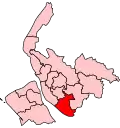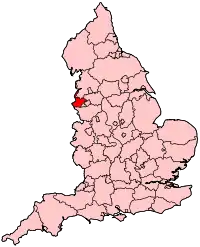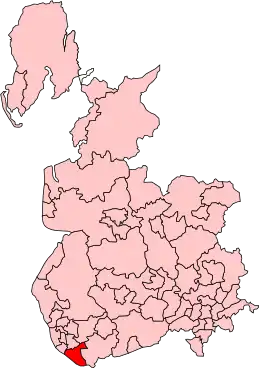53°21′32″N 2°51′50″W / 53.359°N 2.864°W
| Liverpool Garston | |
|---|---|
| Former Borough constituency for the House of Commons | |
 Boundary of Liverpool Garston in Merseyside for the 2005 general election | |
 Location of Merseyside within England | |
| County | Merseyside |
| 1950–2010 | |
| Seats | One |
| Created from | Liverpool East Toxteth and Liverpool Wavertree |
| Replaced by | Garston and Halewood |
Liverpool Garston was a borough constituency represented in the House of Commons of the Parliament of the United Kingdom which existed from 1950 and 2010. It elected one Member of Parliament (MP) by the first past the post system of election.
Further to the completion of the 2023 Periodic Review of Westminster constituencies, the seat will be re-established for the next general election, largely replacing the (to be abolished) constituency of Garston and Halewood.[1]
Boundaries

1950–1955: The County Borough of Liverpool wards of Aigburth, Allerton, Childwall, Garston, Little Woolton, and Much Woolton.
1955–1983: The County Borough of Liverpool wards of Aigburth, Allerton, St Mary's, Speke, and Woolton.[2]
1983–1997: The City of Liverpool wards of Allerton, Netherley, St Mary's, Speke, Valley, and Woolton.
1997–2010: The City of Liverpool wards of Allerton, Grassendale, Netherley, St Mary's, Speke, Valley, and Woolton.
The constituency was one of five covering the city of Liverpool, covering the southern part of the city. As well as Garston, it contained areas such as Allerton, Netherley, Speke and Woolton. Liverpool John Lennon Airport was located in the constituency.
The Liverpool Garston seat was abolished at the 2010 general election following boundary changes. It was replaced with a new Garston and Halewood constituency, also covering part of the Knowsley borough.
Proposed
Further to the 2023 Periodic Review of Westminster constituencies, enacted by the Parliamentary Constituencies Order 2023, from the next general election, due by January 2025, the re-established constituency will be composed of the following wards of the City of Liverpool (as they existed on 1 December 2020):
- Allerton and Hunts Cross; Belle Vale; Church; Cressington; Speke-Garston; Woolton.[3]
The seat will comprise the City of Liverpool wards currently in the, to be abolished, constituency of Garston and Halewood, with the addition of Church ward fro Liverpool Wavertree.
History
The Labour Party held Liverpool Garston from the 1983 general election until the constituency was abolished. Prior to that time the constituency was a fairly safe Conservative seat until Labour gained it in 1974, with the Conservatives regaining it in 1979 for the last time. The Conservative share of the vote declined to less than 10% in the 2005 election, when they came third behind the Liberal Democrats.
Members of Parliament
| Year | Member [4] | Party | |
|---|---|---|---|
| 1950 | Victor Raikes | Conservative | |
| 1957 | Richard Bingham | Conservative | |
| 1966 | Tim Fortescue | Conservative | |
| 1974 | Eddie Loyden | Labour | |
| 1979 | Malcolm Thornton | Conservative | |
| 1983 | Eddie Loyden | Labour | |
| 1997 | Maria Eagle | Labour | |
| 2010 | Constituency abolished | ||
Elections
Elections in the 1950s
| Party | Candidate | Votes | % | ±% | |
|---|---|---|---|---|---|
| Conservative | Victor Raikes | 31,750 | 57.6 | ||
| Labour | Edgar Hewitt | 17,477 | 31.6 | ||
| Liberal | Lyon Blease | 5,966 | 10.8 | ||
| Majority | 14,303 | 26.0 | |||
| Turnout | 55,163 | 84.9 | |||
| Conservative win (new seat) | |||||
| Party | Candidate | Votes | % | ±% | |
|---|---|---|---|---|---|
| Conservative | Victor Raikes | 35,650 | 65.2 | +7.6 | |
| Labour | Alf Morris | 19,025 | 34.8 | +3.2 | |
| Majority | 16,625 | 30.4 | +4.4 | ||
| Turnout | 54,675 | 80.0 | ―4.9 | ||
| Conservative hold | Swing | +2.2 | |||
| Party | Candidate | Votes | % | ±% | |
|---|---|---|---|---|---|
| Conservative | Victor Raikes | 28,130 | 63.5 | ―1.7 | |
| Labour | Thomas Edward Nixon | 16,161 | 36.5 | +1.7 | |
| Majority | 11,969 | 27.0 | ―3.4 | ||
| Turnout | 44,291 | 71.0 | ―1.7 | ||
| Conservative hold | Swing | ―1.7 | |||
| Party | Candidate | Votes | % | ±% | |
|---|---|---|---|---|---|
| Conservative | Richard Bingham | 15,521 | 49.2 | ―14.3 | |
| Labour | Ian Isidore Levin | 11,217 | 35.6 | ―0.9 | |
| Liberal | Arthur Donald Dennis | 4,807 | 15.2 | New | |
| Majority | 4,304 | 13.6 | ―13.4 | ||
| Turnout | 31,545 | ||||
| Conservative hold | Swing | ―6.7 | |||
| Party | Candidate | Votes | % | ±% | |
|---|---|---|---|---|---|
| Conservative | Richard Bingham | 31,441 | 64.5 | +1.0 | |
| Labour | Brian Crookes | 17,284 | 35.5 | ―1.0 | |
| Majority | 14,157 | 29.0 | +2.0 | ||
| Turnout | 48,725 | 74.4 | +3.4 | ||
| Conservative hold | Swing | +1.0 | |||
Elections in the 1960s
| Party | Candidate | Votes | % | ±% | |
|---|---|---|---|---|---|
| Conservative | Richard Bingham | 24,100 | 49.8 | ―14.7 | |
| Labour | John D. Hamilton | 17,626 | 36.4 | +0.9 | |
| Liberal | Frank Kirk | 6,708 | 13.9 | New | |
| Majority | 6,474 | 13.4 | ―15.6 | ||
| Turnout | 48,434 | 72.9 | ―1.5 | ||
| Conservative hold | Swing | ―7.8 | |||
| Party | Candidate | Votes | % | ±% | |
|---|---|---|---|---|---|
| Conservative | Tim Fortescue | 24,716 | 54.4 | +4.6 | |
| Labour | William H. Waldron | 20,746 | 45.6 | +9.2 | |
| Majority | 3,970 | 8.8 | ―4.6 | ||
| Turnout | 45,462 | 68.2 | ―4.7 | ||
| Conservative hold | Swing | ―2.3 | |||
Elections in the 1970s
| Party | Candidate | Votes | % | ±% | |
|---|---|---|---|---|---|
| Conservative | Tim Fortescue | 28,381 | 56.9 | +2.5 | |
| Labour | Colin J. Smith | 21,456 | 43.1 | ―2.5 | |
| Majority | 6,925 | 13.8 | +5.0 | ||
| Turnout | 49,837 | 65.7 | ―2.5 | ||
| Conservative hold | Swing | +2.5 | |||
| Party | Candidate | Votes | % | ±% | |
|---|---|---|---|---|---|
| Labour | Eddie Loyden | 25,332 | 42.4 | ―0.7 | |
| Conservative | Nigel Neville Laville | 24,651 | 41.2 | ―15.7 | |
| Liberal | Geoffrey Howard Black | 9,834 | 16.4 | New | |
| Majority | 681 | 1.2 | N/A | ||
| Turnout | 59,817 | 74.6 | +8.9 | ||
| Labour gain from Conservative | Swing | +7.4 | |||
| Party | Candidate | Votes | % | ±% | |
|---|---|---|---|---|---|
| Labour | Eddie Loyden | 27,857 | 47.8 | +5.4 | |
| Conservative | David Charles Stanley | 24,557 | 42.1 | +0.9 | |
| Liberal | Geoffrey Howard Black | 5,865 | 10.1 | ―6.3 | |
| Majority | 3,300 | 5.7 | +4.5 | ||
| Turnout | 58,299 | 71.9 | ―2.7 | ||
| Labour hold | Swing | +2.3 | |||
| Party | Candidate | Votes | % | ±% | |
|---|---|---|---|---|---|
| Conservative | Malcolm Thornton | 28,105 | 48.1 | +6.0 | |
| Labour | Eddie Loyden | 25,318 | 43.3 | ―4.5 | |
| Liberal | Wilfred John Davidson | 4,890 | 8.4 | ―1.7 | |
| Workers Revolutionary | Terence Kelly | 142 | 0.2 | New | |
| Majority | 2,787 | 4.8 | N/A | ||
| Turnout | 58,455 | 73.8 | +1.9 | ||
| Conservative gain from Labour | Swing | +5.3 | |||
Elections in the 1980s
| Party | Candidate | Votes | % | ±% | |
|---|---|---|---|---|---|
| Labour | Eddie Loyden | 21,450 | 46.6 | ||
| Conservative | James Ross | 17,448 | 37.9 | ||
| Liberal | Rosie Cooper | 7,153 | 15.5 | ||
| Majority | 4,002 | 8.7 | |||
| Turnout | 46,051 | 71.6 | |||
| Labour hold | Swing | ||||
Note: This constituency underwent major boundary changes in 1983 and so was notionally a hold.
| Party | Candidate | Votes | % | ±% | |
|---|---|---|---|---|---|
| Labour | Eddie Loyden | 24,848 | 53.6 | +7.0 | |
| Conservative | Paul Feather | 11,071 | 23.9 | ―14.0 | |
| SDP | Richard Isaacson | 10,370 | 22.4 | +6.9 | |
| Workers Revolutionary | Kevin Timlin | 98 | 0.2 | New | |
| Majority | 13,777 | 29.7 | +21.0 | ||
| Turnout | 46,387 | 75.7 | +4.1 | ||
| Labour hold | Swing | +10.5 | |||
Elections in the 1990s
| Party | Candidate | Votes | % | ±% | |
|---|---|---|---|---|---|
| Labour | Eddie Loyden | 23,212 | 57.1 | +3.5 | |
| Conservative | John Backhouse | 10,933 | 26.9 | +3.0 | |
| Liberal Democrats | Charles Roberts | 5,398 | 13.3 | ―9.1 | |
| Liberal | William Conrad | 894 | 2.2 | New | |
| Natural Law | Peter Chandler | 187 | 0.5 | New | |
| Majority | 12,279 | 30.2 | +0.5 | ||
| Turnout | 40,624 | 70.6 | ―5.1 | ||
| Labour hold | Swing | +0.3 | |||
| Party | Candidate | Votes | % | ±% | |
|---|---|---|---|---|---|
| Labour | Maria Eagle | 26,667 | 61.3 | +10.2 | |
| Liberal Democrats | Flo Clucas | 8,250 | 19.0 | ―2.7 | |
| Conservative | Nigel Gordon-Johnson | 6,819 | 15.7 | ―9.2 | |
| Referendum | Frank Dunne | 833 | 1.9 | New | |
| Liberal | Gary Copeland | 666 | 1.5 | ―0.7 | |
| Natural Law | John Parsons | 127 | 0.3 | ―0.2 | |
| Socialist Equality | Stuart Nolan | 120 | 0.3 | New | |
| Majority | 18,417 | 42.3 | +12.1 | ||
| Turnout | 43,482 | 65.0 | ―5.6 | ||
| Labour hold | Swing | +7.7 | |||
Elections in the 2000s
| Party | Candidate | Votes | % | ±% | |
|---|---|---|---|---|---|
| Labour | Maria Eagle | 20,043 | 61.4 | +0.1 | |
| Liberal Democrats | Paula Keaveney | 7,549 | 23.1 | +4.1 | |
| Conservative | Helen Sutton | 5,059 | 15.5 | ―0.2 | |
| Majority | 12,494 | 38.3 | ―4.0 | ||
| Turnout | 32,651 | 50.2 | ―14.8 | ||
| Labour hold | Swing | ―2.0 | |||
| Party | Candidate | Votes | % | ±% | |
|---|---|---|---|---|---|
| Labour | Maria Eagle | 18,900 | 54.0 | ―7.4 | |
| Liberal Democrats | Paula Keaveney | 11,707 | 33.5 | +10.4 | |
| Conservative | Amber Rudd | 3,424 | 9.8 | ―5.7 | |
| UKIP | Kevin Kearney | 780 | 2.2 | New | |
| Workers Revolutionary | David Oatley | 163 | 0.5 | New | |
| Majority | 7,193 | 20.5 | ―17.8 | ||
| Turnout | 34,974 | 54.9 | +4.7 | ||
| Labour hold | Swing | ―8.9 | |||
See also
Notes and references
- ↑ "North West | Boundary Commission for England". boundarycommissionforengland.independent.gov.uk. Retrieved 15 June 2023.
- ↑ Craig, F.W.S., ed. (1972). Boundaries of parliamentary constituencies 1885-1972. Chichester, Sussex: Political Reference Publications. ISBN 0-900178-09-4.
- ↑ "The Parliamentary Constituencies Order 2023". Schedule 1 Part 5 North West region.
- ↑ Leigh Rayment's Historical List of MPs – Constituencies beginning with "G" (part 1)
- ↑ "Election Data 1983". Electoral Calculus. Archived from the original on 15 October 2011. Retrieved 18 October 2015.
- ↑ "Election Data 1987". Electoral Calculus. Archived from the original on 15 October 2011. Retrieved 18 October 2015.
- ↑ "Election Data 1992". Electoral Calculus. Archived from the original on 15 October 2011. Retrieved 18 October 2015.
- ↑ "Politics Resources". Election 1992. Politics Resources. 9 April 1992. Archived from the original on 24 July 2011. Retrieved 6 December 2010.
- ↑ "Election Data 1997". Electoral Calculus. Archived from the original on 15 October 2011. Retrieved 18 October 2015.
- ↑ "Election Data 2001". Electoral Calculus. Archived from the original on 15 October 2011. Retrieved 18 October 2015.
- ↑ "Election Data 2005". Electoral Calculus. Archived from the original on 15 October 2011. Retrieved 18 October 2015.